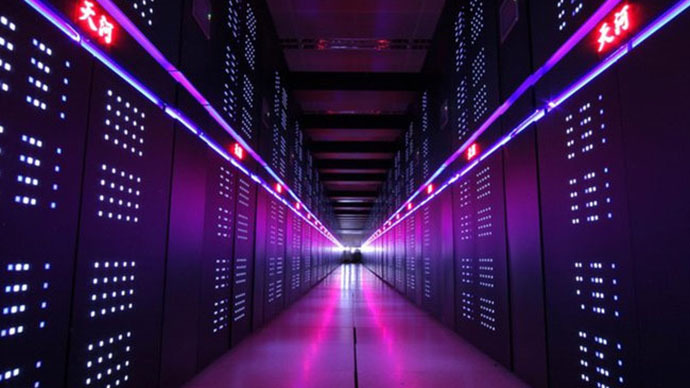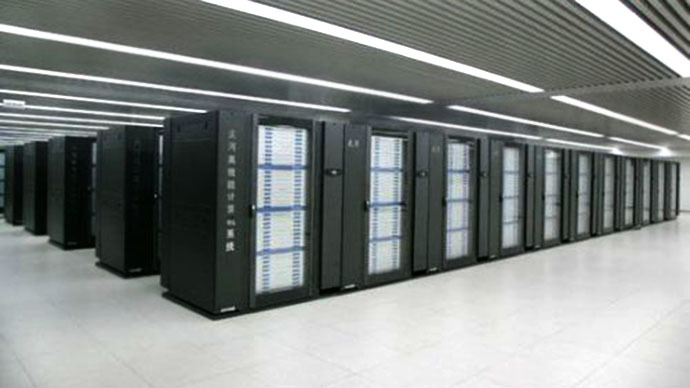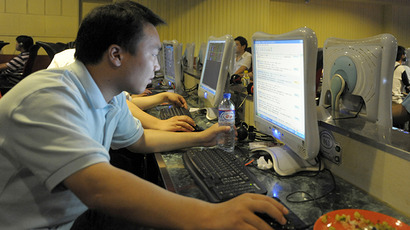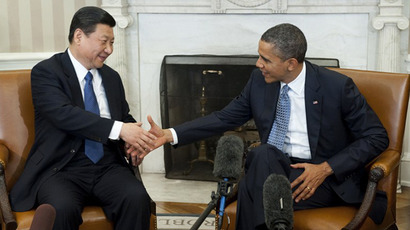Chinese supercomputer twice as fast as closest US rival

China’s showpiece Tianhe-2 computer is almost twice as fast as its nearest rival, according to a new ranking. But the simple benchmark used to rate the powerful “research and education tool” may not effectively measure the supercomputer’s true usefulness.
Tianhe-2, which means ‘Milkyway 2,’ runs at 33.86 petaflops. This
is equivalent to 33,863 trillion calculations per second. The
device, which uses US-designed Intel microchips, was turned on
earlier this year and is being run by Guangzhou’s city
government.
The internationally recognized Top500 ranking, which is
twice-yearly compiled by scientists at the University of
Mannheim, gives computers a specific type of mathematical
equation which allows for direct comparison, known as the
‘Linpack benchmark.’
China’s National University of Defense Technology (NUDT) says
that Tianhe-2 was developed for government security applications,
various simulations, and analysis. Packed with 16,000 computer
nodes, it has 3,120,000 cores. The total CPU plus coprocessor
memory is 1,375 terabytes.
The interconnect system, operating system, front-end processors,
and software were all developed by Chinese scientists. The system
is the most energy-efficient configuration in the top 10, with
2.33 megawatts consumption of power that delivers 2.7
Gigaflops-per-watt of performance.
"The major challenge is for China to develop the computing
chip technology so it can build the whole computer with Chinese
parts. Application software also presents a great challenge,"
Jack Dongarra, professor at the University of Tennessee and
Top500 editor, told Xinhua.
Tianhe-2, to be officially launched at the end of this year, is
designed as a "research and education" tool. It can be
used in a variety of China’s commercial industries and in a
number of research fields that need to process a lot of raw data,
such as physics.
The $390 million mega-system can multitask and is able to operate
traffic lights, predict earthquakes, be used in pharmaceutical
and car industries, and create movie special effects, Xinhua
reports.

Tianhe’s nearest rival, the two-year-old Titan at the Oak Ridge National Laboratory, has a capacity of 17.59 petaflops.
"The Tianhe-2 is a very powerful computing system," Dongarra said. "It has almost two times the performance of the number 2 system, Titan. I wouldn't be surprised if it was in the number 1 position for another year."
Despite being far behind – and also with no record-breaking supercomputers in the pipeline for the next couple of years – the US can still console itself with five places in the top 10, and with 265 in the top 500. China is in second place with 63 supercomputers in the top 500.
According to the updated list, the combined performance of all 500 systems is 250 petaflops. The top 17 systems on the list are responsible for half of the total performance, with the other half sharing the total performance between 483 systems.
Europe appears to be falling behind, with 102 computers on the list – 10 less than six months ago. Russia’s leading supercomputer, located at Moscow State University, and is ranked 37th.
But the scientists behind the project are increasingly aware that a theoretical benchmark is a poor reflection of the usefulness of supercomputers in solving specific tasks for which they are constructed, and in no way measure whether a supercomputer is being used productively.
"A very simple benchmark, like the Linpack, cannot reflect the reality of how many real application perform on today's complex computer systems," said Erich Strohmaier, one of the authors of the Top500.
"More representative benchmarks have to be much more complex in their coding, their execution and how many aspects of their performance need to be recorded and published. This makes understanding their behavior more difficult.”














